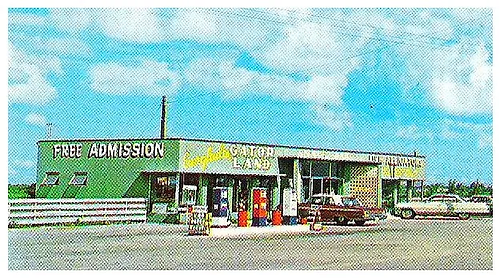
The Urban Coroner
Photography By Sugarbomb
EVERGLADES GATORLAND
A former roadside attraction in the middle of the Everglades.

Everglades Gatorland painted on the front of the building | Photo © 2017 Sugarbomb
Before my surprise at seeing the name of the long-dead town Okeelanta show up on my map app had completely faded, I was making a sharp U-turn and pulling into the patch of gravel and dirt that had once been the pavement in front of Everglades Gatorland.
Beginning in Miami’s Little Havana and exiting the state at the small town of Havana near the Florida/Georgia state line, US-27 cuts through the depths of the swamps and groves that make up Florida. Though it's now barely more than a rural afterthought, this was once the road millions of migrants in search of new opportunities and tourists in search of new sights and thrills would use to travel throughout the state of Florida. This cross-country route that predated modern interstates passes through Florida, Georgia, Tennessee, and Kentucky, stretching briefly into Ohio before diverting into Indiana, and ending at Interstate 69 in Fort Wayne. Because it was so heavily traveled, US-27 was once the backbone of Florida’s tourism industry and before Disney World reigned supreme, kitschy roadside attractions were the main draw for travelers.
Just south of Lake Okeechobee and the town of South Bay on US-27 is what remains of Everglades Gatorland, a small roadside zoo and souvenir shop which became known for their live alligators. Originally a gas station run by J.C. Bowen, former mayor of South Bay, and his wife Mary Lou, Everglades Gatorland was inspired by the many tourists who would stop to fuel up and ask where they could see alligators and other native Florida animals. This impelled the couple to open Everglades Gatorland in 1959 with alligators caught in the lake just behind the building.
In addition to the alligators for which it was named, the menagerie at Everglades Gatorland would eventually expand and acquire exotic animals such as ocelots, coati, and a king vulture.
A 1960s era postcard from Everglades Gatorland advertised "located on US Highway 27 offers you FREE ADMISSION to see live alligators and many other wild animals that inhabit the Everglades. Visit Florida's most modern gift shop and Snack Bar, on the northeast corner of the Everglades."
1960s postcard from Everglades Gatorland | Photo © mainmanwalkin on Flickr
In the 1960s, alligator poaching had intensified, and poachers had made off with three of the alligators from Gatorland while the night watchman was off duty in 1965. The American Alligator was added to the first endangered species list in 1967. For more than a century, alligators had been hunted for their meat and hides, greatly diminishing their numbers to the point that many believed the species would never recover.
That same year, Florida became the first state in the country to establish its own new regulations regarding captive animals. These regulations established standards for minimum pen size for each group of animals, sanitation, and animal care requirements that eventually put many similar roadside zoos out of business when they couldn't adhere to these new regulations. Everglades Gatorland, however, was able to meet the requirements and stay in business.

The lake behind Everglades Gatorland where the first alligators of the roadside zoo were caught | Photo © 2017 Sugarbomb
The establishment remained open and thrived throughout the 70s and 80s, but by the 1990s there weren’t any gators left at Everglades Gatorland because the time and cost to care for them was no longer worth it, at least financially. Thanks to the heightened restrictions on hunting, the population of alligators recovered enough that by 1987 the species was listed as threatened rather than endangered. The old Florida tourist shops along Highway 27 would not have the same sort of resurgence.
The construction and expansion of large interstate highways like I-95 and I-75 and the Florida Turnpike in previous decades had been steadily diverting much of the traffic away from these old routes as well. Without the gators promised in bold print on the front of the building, there was not much to draw in visitors beyond a quick stop for fuel. Business declined over the following years, but the Bowens continued selling souvenirs to the rare tourist who would pass through before finally closing and surrendering the building to the Everglades from whence it came.

Old wooden enclosures behind Everglades Gatorland | Photo © 2017 Sugarbomb
The former tourist attraction is now an empty building, roof long since fallen in, but otherwise empty. The only sign of what it once was are the sun-bleached letters on the front of the building advertising "LIVE ALLIGATORS!" This advertisement is likely correct, as there are no doubt countless alligators waiting nearby to make a meal out of anything or anyone that wanders blindly into their swamp.
I could vaguely see some smaller structures and animal pens out beyond the main building, lining a path that led to the very lake where the original gators of Gatorland had been caught. In the city, OG stands for "original gangster" but out here in the Everglades it means "original gator" – the most hardcore of gators – and they're probably all watching you at any given time from the rapidly encroaching foliage that is just waiting to swallow this place up.

Everglades Gatorland shrouded in overgrowth | Photo © 2016 Sugarbomb
In October 2020 crews finished the work that nature had already started and demolished the old Everglades Gatorland and the old pens and remains of the alligator pits. Curious tourists looking for a taste of old Florida can still have an up close and personal encounter with alligators and Florida wildlife though – if you stroll around the Everglades, you’ll definitely see a gator. Just be aware that the gators will definitely see you first.

Panoramic shot of what remains of the front of Everglades Gatorland | Photo © 2017 Sugarbomb


















